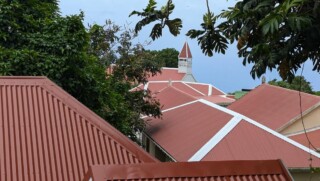18th-century Burial Ground found during Excavation in St. Eustatius

The Public Entity St Eustatius and St. Eustatius Center for Archaeological Research (SECAR) confirm that an 18th– century burial ground has been found at the Golden Rock 2021 site. It is premature to say if the bodies are those of formerly enslaved persons, however most have been identified as having African features.
Twelve skeletons have been discovered to date, Thursday, May 6th 2021. More are expected to lie in this burial ground. All of these remains have been found in unmarked and unmapped locations. “It is imperative that the remains are excavated and removed from the site. We do this in order to process, conserve, analyze and eventually rebury these people in a proper and respectful way,” says GR2021 Director, Ruud Stelten. “If the burial grounds contain the estimated number of graves which we anticipate, this site will be one of the largest rural burial grounds to be fully excavated in the Caribbean,” adds Ruud Stelten.
It is currently not possible to determine if the discovered remains were actual enslaved persons or freed persons of African descent. The archaeologists continue to research carefully and hope to be able to determine the social status of the persons in the burial grounds. The majority of the burials have some remains of coffin, coffin nails and objects which were buried with these people. This indicates that the deceased persons were treated with care and respect.
GR2021 also has a forensic archaeologist on the team. If an intact skull is discovered, she can make a digital facial reconstruction of the buried person.
Former Statian archaeologist Joost Morsink, who is responsible for the Amerindian settlement portion of GR2021, has stated that no human remains have been found to date during this dig, but has unearthed many interesting clues as to how the Amerindians lived in the 7th to 9th century AD.
Artifacts
Multiple archaeological features and artifacts appeared during the test trench phase. These were indicative of a settlement which is projected to be the area of the slave quarters of the former Golden Rock Plantation. It is in this precise area that burials have been found. The remains and all the artifacts which are being found, will be stored in a secured climate-controlled environment. This is particularly important for the archaeological remains as their DNA will be analyzed.
A cooperation has been set up with several prominent universities around the world to analyze the remains in order to learn more about the lives of the buried people. Stable isotope analysis can inform us of peoples’ diets and whether they were born on Statia. DNA analysis can tell us where in Africa these people came from. Through protein studies it is also possible to discover what diseases they suffered from and what eventually took their lives.
Test trenches
In September 2020 the Public Entity St. Eustatius requested SECAR to perform test trenches in a high archaeological expectancy area. The dirt and sand located in this area are intended to be used for ongoing projects carried out by the Environment, Nature and Infrastructure directorate (ENI). This area will also be used for future airport expansion projects.
The Amerindian settlement which is nearby and part of GR2021, has not revealed any human remains during this dig but has unearthed many interesting clues as to how the Amerindians lived in the 7th to 9th century AD.
The Public Entity is pleased that so many specialists have come to Statia in order to assist SECAR. “Thanks to the protocol of testing sensitive areas before digging, these findings have been saved from being destroyed and the stories which are emerging about the island’s history and heritage are fascinating,” says Natasha Radjouki, Program Manager of the Culture Department of the Public Entity.
On Wednesday, May 5th 2021, members of the Island Council were briefed by Acting Government Commissioner Alida Francis and Ruud Stelten of SECAR on the significance of this archaeological excavation.












